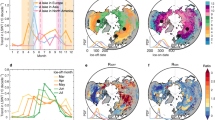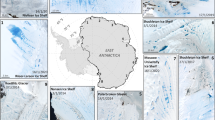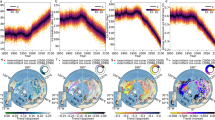Abstract
Eleven thousand years ago, large lakes existed in central and eastern North America along the margin of the Laurentide Ice Sheet. The large-scale North American climate at this time has been simulated with atmospheric general circulation models1,2, but these relatively coarse global models do not resolve potentially important features of the mesoscale circulation that arise from interactions among the atmosphere, ice sheet, and proglacial lakes. Here we present simulations of the climate of central and eastern North America 11,000 years ago with a high-resolution, regional climate model nested within a general circulation model. The simulated climate is in general agreement with that inferred from palaeoecological evidence. Our experiments indicate that through mesoscale atmospheric feedbacks, the annual delivery of moisture to the Laurentide Ice Sheet was diminished at times of a large, cold Lake Agassiz relative to periods of lower lake stands. The resulting changes in the mass balance of the ice sheet may have contributed to fluctuations of the ice margin, thus affecting the routing of fresh water to the North Atlantic Ocean. A retreating ice margin during periods of high lake level may have opened an outlet for discharge of Lake Agassiz into the North Atlantic. A subsequent advance of the ice margin due to greater moisture delivery associated with a low lake level could have dammed the outlet, thereby reducing discharge to the North Atlantic. These variations may have been decisive in causing the Younger Dryas cold event3,4.
This is a preview of subscription content, access via your institution
Access options
Subscribe to this journal
Receive 51 print issues and online access
$199.00 per year
only $3.90 per issue
Buy this article
- Purchase on Springer Link
- Instant access to full article PDF
Prices may be subject to local taxes which are calculated during checkout



Similar content being viewed by others
References
Pollard, D. et al. Climate simulations for 10000 and 6000 years BP using the GENESIS global climate model. Paleoclimates 2, 183–218 (1998).
Bartlein, P. J. et al. Paleoclimate simulations for North America over the past 21,000 years: Features of the simulated climate and comparisons with paleoenvironmental data. Quat. Sci. Rev. 17, 549– 585 (1998).
Broecker, W. S. et al. Routing of meltwater from the Laurentide ice sheet during the Younger Dryas cold episode. Nature 341, 318–321 (1989).
Teller, J. T. Meltwater and precipitation runoff to the North Atlantic, Arctic, and Gulf of Mexico from the Laurentide ice sheet and adjacent regions during the Younger Dryas. Paleoceanography 5, 897– 905 (1990).
Thompson, S. L. & Pollard, D. A global climate model (GENESIS) with a land-surface-transfer scheme (LSX), 1, Present-day climate. J. Clim. 8, 732– 761 (1995).
Dorman, J. L. & Sellers, P. J. A global climatology of albedo, roughness length, and stomatal resistance for atmospheric general circulation models as represented by the simple biosphere model (SiB). J. Appl. Meteorol. 28, 833–855 ( 1989).
Licciardi, J. M., Clark, P. U., Jenson, J. W. & MacAyeal, D. R. Deglaciation of a soft-bedded Laurentide ice sheet. Quat. Sci. Rev. 17, 427–448 ( 1998).
Peltier, W. R. Ice age paleotopography. Science 265, 195 –201 (1994).
Giorgi, F., Marinucci, M. R. & Bates, G. T. Development of a second-generation regional climate model (RegCM2), I, Boundary layer and radiative processes. Mon. Weath. Rev. 121, 2794–2813 (1993).
Giorgi, F., Marinucci, M. R. & Bates, G. T. Development of a second-generation regional climate model (RegCM2), II, Convective processes and assimilation of boundary conditions. Mon. Weath. Rev. 121, 2814– 2832 (1993).
Hostetler, S. W. & Bartlein, P. J. in Mechanism of Global Climate Change at Millennial Time Scales (eds Clark, P. U., Webb, R. S. & Keigwin, L.) 313–328 (AGU Monograph Series, American Geophysical Union, Washington, DC, 1999).
Small, E. E., Sloan, L. C., Hostetler, S. W. & Giorgi, F. Simulating the water balance of the Aral Sea with a coupled regional climate-lake model. J. Geophys. Res. 104, 6583– 6602 (1999).
Hostetler, S. W., Giorgi, F., Bates, G. T. & Bartlein, P. J. Lake-atmosphere feedbacks associated with paleolakes Bonneville and Lahontan. Science 263, 665–668 ( 1994).
Mann, J. D., Leverington, J. D., Rayburn, J. & Teller, J. T. The volume and paleobathymetry of glacial Lake Agassiz. J. Paleolimnol. 22, 71–89 ( 1999).
Curry, B. B. Paleochemistry of Lakes Agassiz and Manitoba based on ostracodes. Can. J. Earth Sci. 34, 699–708 (1997).
Mann, J. D. et al. Calculating the volume and heat budget of glacial Lake Agassiz. GSA Ann. Meeting Abstr. 29, A111 (1997).
Clayton, L., Moran, S. R. & Bluemle, J. P. Intersecting minor lineations on Lake Agassiz plain. J. Geol. 73, 652–656 (1965).
Licciardi, J. M., Teller, J. T. & Clark, P. U. in Mechanism of Global Climate Change at Millennial Time Scales (eds Clark, P. U., Webb, R.S. & Keigwin, L.) 177 –202 (AGU Monograph Series, American Geophysical Union, Washington, DC, 1999).
Dyke, S. & Prest, V. K. Map 1703A (Geological Survey of Canada, Ottawa, 1987).
Bates, G. T., Hostetler, S. W. & Giorgi, F. Two-year simulation of the Great Lakes region with a coupled modeling system. Mon. Weath. Rev. 123, 1505–1522 (1995).
Giorgi, F. et al. Regional nested model simulations of present day and 2XCO 2 climate over the Great Plains of the US. Clim. Change 40, 457–493 (1998).
Hostetler, S. W. Climate near to the edge of an ice sheet. Nature 385 , 393–394 (1997).
Webb, T., Bartlein, P. J., Harrison, S. P. & Anderson, K. H. in Global Climates Since the Last Glacial Maximum (eds Wright, H. E., Kutzbach, J. E., Webb, T., Ruddiman, W. F., Street-Perrott, F. A. & Bartlein, P. J.) 415–467 (Univ. Minnesota Press, 1993).
Levesque, A. J., Cwynar, L. C. & Walker, I. R. Exceptionally steep north-south gradients in lake temperature during the last deglaciation. Nature 385 , 423–426 (1997).
Laird, K. R., Fritz, S. C., Grimm, E. C. & Mueller, P. G. Century-scale paleoclimatic reconstruction from Moon Lake, a closed-basin lake in the northern Great Plains. Limnol. Oceanogr. 41, 890–902 (1996).
Bartlein, P. J. & Whitlock, C. in Elk Lake, Minnesota: Evidence for Rapid Climate Change in the North-Central United States (eds Bradbury, J. P. & Dean, W. E.) 275– 293 (Geologic Society of America, Boulder, 1993).
Hu, F. S., Wright, H. E., Ito, E. & Lease, K. Climate effects of glacial Lake Agassiz in the midwestern United States during the last deglaciation. Geology 25, 207–210 (1997).
Overpeck, J. T., Webb, R. S. & Webb, T. W. Mapping eastern North American vegetation change of the past 18 ka: no-analogs and the future. Geology 20, 1071–1074 (1992).
Teller, J. T. in North America and Adjacent Oceans During the Last Deglaciation (eds Ruddiman, W. F. & Wright, H. E.) 39–69 (Geological Society of America, Boulder, 1986).
Lowell, T. V., Larson, G. H., Hughes, J. D. & Denton, G. H. Age verification of the Lake Gribben forest bed and the Younger Dryas advance of the Laurentide Ice Sheet. Can. J. Earth Sci. 36, 383–393 (1999).
Acknowledgements
We thank F. S. Hu, E. Ito, and H. E. Wright for discussions, D. Pollard and J. Teller for discussions and critical reviews, and R. Gallimore, F. Giorgi and D. Zahnle for assistance. Model simulations were conducted at NCAR and the National Environmental Super Computer (NESC) facility of the US Environmental Protection Agency. Special thanks to NESC for help in completing our model simulations. This work was supported by the US Geological Survey (S.W.H.), the National Science Foundation (P.J.B., P.U.C., E.E.S.), and the US Environmental Protection Agency (A.M.S.).
Author information
Authors and Affiliations
Corresponding author
Rights and permissions
About this article
Cite this article
Hostetler, S., Bartlein, P., Clark, P. et al. Simulated influences of Lake Agassiz on the climate of central North America 11,000 years ago. Nature 405, 334–337 (2000). https://doi.org/10.1038/35012581
Received:
Accepted:
Issue Date:
DOI: https://doi.org/10.1038/35012581
This article is cited by
-
Impacts of climate change on hydrological processes in the Tibetan Plateau: a case study in the Lhasa River basin
Stochastic Environmental Research and Risk Assessment (2015)
-
A retrospective look at coupled ice sheet–climate modeling
Climatic Change (2010)
-
A framework for regional modeling of past climates
Theoretical and Applied Climatology (2006)
-
Atmosphere-land cover feedbacks alter the response of surface temperature to CO2 forcing in the western United States
Climate Dynamics (2005)
-
Modeling the history of Lake of the Woods since 11,000 cal yr B.P. using GIS
Journal of Paleolimnology (2005)
Comments
By submitting a comment you agree to abide by our Terms and Community Guidelines. If you find something abusive or that does not comply with our terms or guidelines please flag it as inappropriate.



